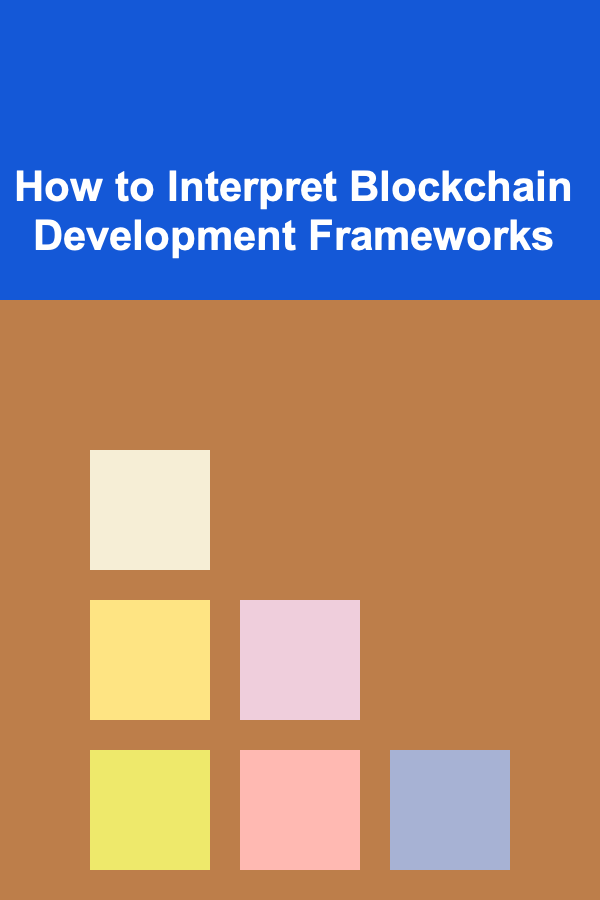
How to Interpret Blockchain Development Frameworks
ebook include PDF & Audio bundle (Micro Guide)
$12.99$10.99
Limited Time Offer! Order within the next:

Blockchain technology has revolutionized how we approach data security, transparency, and decentralized applications. It underpins cryptocurrencies like Bitcoin and Ethereum, but its potential extends far beyond these uses. Developers and enterprises are increasingly looking at blockchain as a solution to complex challenges across various industries. To leverage blockchain for innovative solutions, understanding the development frameworks that enable the creation of decentralized applications (dApps) is crucial.
In this article, we will delve into how to interpret blockchain development frameworks, exploring their role, benefits, and practical applications in building blockchain-based systems.
What is a Blockchain Development Framework?
A blockchain development framework is a set of tools, libraries, and best practices that aid in the design, development, and deployment of blockchain solutions. It provides developers with predefined structures, templates, and functions to work with, reducing the complexity of creating blockchain applications from scratch.
Blockchain development frameworks typically support:
- Smart Contract Development: Enabling the creation and execution of smart contracts.
- Consensus Mechanisms: Integrating various methods of achieving agreement on the state of a blockchain (e.g., Proof of Work, Proof of Stake).
- Blockchain Nodes: Facilitating the connection and communication between blockchain nodes.
- Data Storage: Providing ways to handle and store data on a decentralized ledger.
Frameworks vary in terms of their support for specific blockchain platforms, features, and scalability. Understanding how to choose and interpret a blockchain framework is key to leveraging the full potential of blockchain technology.
Popular Blockchain Development Frameworks
There are several well-known blockchain development frameworks, each with its own strengths and limitations. Below, we'll explore some of the most widely adopted frameworks.
2.1 Ethereum (Truffle Suite)
Ethereum is one of the most prominent blockchain platforms that enable decentralized applications (dApps) to run smart contracts. The Truffle Suite is a powerful development framework for Ethereum that provides developers with a suite of tools for building and deploying smart contracts.
Key Features of Truffle Suite:
- Truffle: A smart contract development environment, testing framework, and asset pipeline for Ethereum.
- Ganache: A personal blockchain for Ethereum development used to test dApps.
- Drizzle: A library that simplifies the interaction between frontend applications and Ethereum blockchain.
- Truffle Boxes: Pre-configured templates that help developers get started quickly with common use cases.
Truffle is ideal for developers familiar with the Ethereum Virtual Machine (EVM) and its ecosystem, making it easy to write, test, and deploy smart contracts. It abstracts many of the complexities of blockchain development, allowing developers to focus on business logic rather than infrastructure.
2.2 Hyperledger
Hyperledger is an open-source project aimed at developing frameworks and tools for enterprise blockchain applications. Unlike Ethereum, which is public and permissionless, Hyperledger focuses on permissioned blockchains suitable for business use cases, such as supply chain management and finance.
Key Features of Hyperledger:
- Hyperledger Fabric: A modular blockchain framework that provides a flexible architecture for building enterprise-grade blockchain networks.
- Hyperledger Sawtooth: A platform that uses a novel consensus algorithm called Proof of Elapsed Time (PoET) and is optimized for the IoT industry.
- Hyperledger Indy: A blockchain platform designed for decentralized identity management.
Hyperledger is particularly suited for organizations looking to maintain control over their blockchain environment, offering privacy, security, and scalability. The modular nature of Hyperledger allows for the customization of consensus mechanisms and other key components.
2.3 Corda
Developed by R3, Corda is a permissioned blockchain platform designed specifically for financial institutions. Corda allows parties to transact directly with each other in a secure and private environment, making it ideal for industries like banking and insurance.
Key Features of Corda:
- Smart Contracts: Corda's smart contracts are highly customizable, enabling business logic to be programmed in a way that matches the specific needs of financial institutions.
- Privacy: Corda is designed to allow private transactions between parties, ensuring that only authorized participants can view the details of a transaction.
- Interoperability: Corda supports interoperability with existing enterprise systems, making it easier for companies to integrate blockchain into their legacy infrastructure.
Corda stands out for its ability to enable complex financial transactions and its focus on privacy and regulatory compliance, essential in financial services.
2.4 Solana
Solana is a high-performance blockchain platform designed for decentralized applications and cryptocurrencies. It aims to provide scalability and low latency for decentralized applications while maintaining decentralization.
Key Features of Solana:
- Proof of History (PoH): Solana's unique consensus mechanism that timestamps transactions to achieve greater scalability.
- Low Transaction Costs: Solana can handle thousands of transactions per second with minimal fees, making it attractive for applications requiring high throughput.
- Smart Contract Support: Solana allows developers to create smart contracts using the Rust programming language.
Solana is ideal for decentralized finance (DeFi) applications, gaming, and other high-throughput use cases, offering a fast and scalable blockchain platform.
Key Considerations When Choosing a Blockchain Framework
When interpreting and selecting a blockchain framework, developers should consider several factors to ensure they are choosing the best tool for their specific use case. Below are some critical considerations:
3.1 Platform Type
Blockchains can be classified into public, private, and permissioned types. Public blockchains (e.g., Bitcoin, Ethereum) are open to anyone, while private or permissioned blockchains are typically used by enterprises that require more control over the network.
- Public Blockchains: Decentralized, open for anyone to participate.
- Private Blockchains: Controlled by a single entity, often used for internal business operations.
- Permissioned Blockchains: Restricted to a set of known participants with specific roles.
Depending on whether your application requires open access or controlled access, you'll need to choose a framework that supports your desired blockchain type.
3.2 Consensus Mechanism
The consensus mechanism determines how transactions are validated and added to the blockchain. Common consensus algorithms include:
- Proof of Work (PoW): Used by Bitcoin and Ethereum 1.0. It requires computational work to validate transactions.
- Proof of Stake (PoS): Ethereum 2.0 and other newer blockchains use PoS to reduce energy consumption and improve scalability.
- Practical Byzantine Fault Tolerance (PBFT): Common in permissioned blockchains like Hyperledger Fabric.
Consider the consensus mechanism supported by the framework and whether it aligns with your project's requirements for speed, scalability, and security.
3.3 Programming Languages
Blockchain frameworks may support different programming languages. Some of the most common languages include:
- Solidity: Used primarily with Ethereum and its derivatives.
- Go: A statically typed language often used with frameworks like Hyperledger Fabric.
- Rust: Commonly used with Solana and Polkadot for high-performance blockchain applications.
- JavaScript: Used in many blockchain platforms for web interfaces and interacting with smart contracts.
Choosing a framework that supports a programming language you're comfortable with or that is best suited for your project's technical requirements is essential.
3.4 Ecosystem and Community Support
A vibrant community can make a significant difference in the development process. Frameworks with active communities offer:
- Documentation: Comprehensive and up-to-date guides, tutorials, and references.
- Open-Source Contributions: Access to community-driven improvements and fixes.
- Forums and Discussion Groups: Platforms for troubleshooting and sharing ideas.
A strong ecosystem can provide critical support when encountering technical challenges during development.
Understanding Blockchain Development Framework Components
Each blockchain development framework is made up of several components that work together to facilitate the creation of decentralized applications. These include:
4.1 Smart Contract Templates
Frameworks often come with predefined smart contract templates that help developers quickly deploy common functionalities. For example, an Ethereum framework like Truffle offers templates for ERC-20 tokens, which can be customized for creating and managing cryptocurrencies.
4.2 Decentralized Storage
Decentralized storage solutions like IPFS (InterPlanetary File System) allow for secure storage of files and data on the blockchain. Many frameworks integrate with such storage solutions to handle large datasets that cannot be stored directly on the blockchain.
4.3 Blockchain Clients
Blockchain clients are the software interfaces that enable interaction with the blockchain network. These clients communicate with nodes, submit transactions, and query data. Popular blockchain clients include geth (for Ethereum) and Corda Node (for Corda).
4.4 Testing and Debugging Tools
Blockchain development frameworks provide testing tools like Ganache for Ethereum, which allows developers to simulate the blockchain environment locally. Testing is a crucial step in ensuring that smart contracts and decentralized applications function as expected.
4.5 Deployment Tools
Once the application is developed, deployment tools facilitate its launch on a live blockchain network. These tools help developers manage nodes, interact with the network, and deploy smart contracts securely.
Challenges in Blockchain Development Frameworks
Despite their advantages, blockchain development frameworks come with their own set of challenges, including:
- Scalability: Blockchain networks often face scalability issues, especially public blockchains with high transaction volumes.
- Security: Blockchain applications are targets for malicious actors, requiring careful design and testing to mitigate vulnerabilities.
- Regulatory Compliance: Blockchain technology operates in a legal gray area, with many regions still developing regulations for its use.
Conclusion
Interpreting blockchain development frameworks is essential for anyone looking to build decentralized applications. Whether you are working on a public blockchain like Ethereum or a permissioned platform like Hyperledger, selecting the right framework can significantly influence the success of your project. By understanding the features, components, and considerations that go into choosing a framework, developers can create secure, scalable, and efficient blockchain-based solutions for a wide range of use cases.
As the blockchain ecosystem continues to evolve, staying informed about the latest advancements in development frameworks will help you harness the full potential of blockchain technology.

How to Create a Pet-Proof Garden for Dogs and Cats
Read More
How to Design a Luxury Gift Wrapping Station
Read More
How to Maintain an Inventory of Laundry Supplies
Read More
How to Soundproof a Bedroom for Better Privacy
Read More
How to Understand the Impact of Cold Weather on EV Range
Read More
How to Use Shelving Units for Fishing Gear Storage
Read MoreOther Products

How to Create a Pet-Proof Garden for Dogs and Cats
Read More
How to Design a Luxury Gift Wrapping Station
Read More
How to Maintain an Inventory of Laundry Supplies
Read More
How to Soundproof a Bedroom for Better Privacy
Read More
How to Understand the Impact of Cold Weather on EV Range
Read More